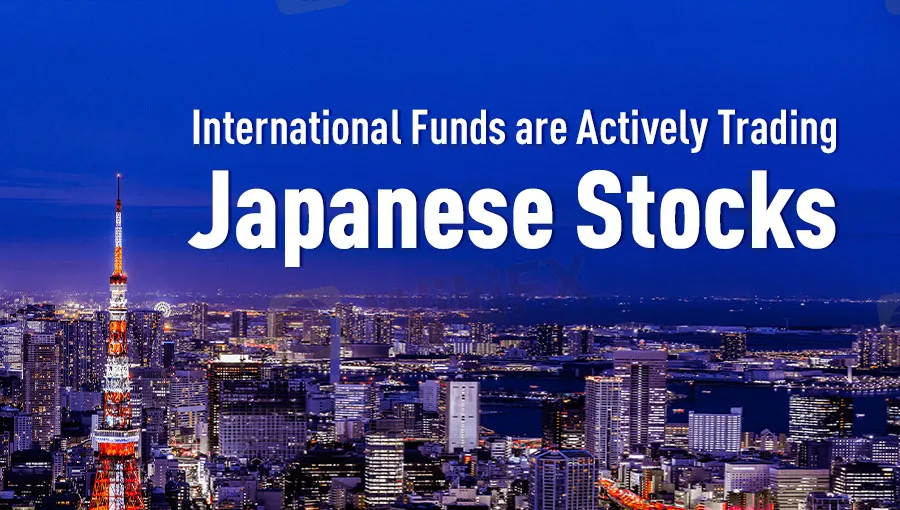简体中文
繁體中文
English
Pусский
日本語
ภาษาไทย
Tiếng Việt
Bahasa Indonesia
Español
हिन्दी
Filippiiniläinen
Français
Deutsch
Português
Türkçe
한국어
العربية
International Funds are Actively Trading Japanese Stocks
Abstract:Japan has been the weakest major currency in the past month. Besides the rising market optimism over trade negotiation and Brexit which reduced demand for safe-haven assets, increase in the trading of Japanese stocks by overseas investors has been another notable factor weighing on the yen.

Japan has been the weakest major currency in the past month. Besides the rising market optimism over trade negotiation and Brexit which reduced demand for safe-haven assets, increase in the trading of Japanese stocks by overseas investors has been another notable factor weighing on the yen. The mechanism behind this is international funds are actively trading Japanese stocks, yet unwilling to bear the associate currency risks.
Most of the players trading on the Japanese stock market are international hedge funds, and their connecting of equities to the JPY has a significant impact over the currency rate. Due to its high liquidity and well-established market infrastructure for high-frequency trading, Japanese stock market has become a favored ground for short-term trading.
Currently, oversea funds‘ share in Japan’s stock trading has climbed to its highest since 2005, accounting for over 60% of the total trade volume. Such dominance is even more obvious in derivatives, in which oversea funds account for nearly 80% of the total trade volume. Oversea investors would try to avoid taking equity risk and currency risks at the same time. When the stock market easily moves by 10% or 20%, currency hedging needs to be raised or reduced accordingly.
Notably, the increase in overseas trading of Japanese stocks and the related currency hedging is showing an implication on another long-running theme - the inverse relation between the yen and the Nikkei 225 Stock Average. According to the statistics compiled by Bloomberg, the yen and the Japanese stocks remained negatively co-related for most of the time since 2006, with the trend approaching a record high since November, 2007.

Disclaimer:
The views in this article only represent the author's personal views, and do not constitute investment advice on this platform. This platform does not guarantee the accuracy, completeness and timeliness of the information in the article, and will not be liable for any loss caused by the use of or reliance on the information in the article.
Read more

Keep Silence to FX Scams? NO! EXPOSE Them on WikiFX!
Keep Silence to FX Scams? NO! EXPOSE Them on WikiFX!

Watch out! PlatformsFx Robbed Me of US$76,878
A few months ago, a person from the trading solution provider company “PlatformsFx” contacted the victim for forex trading. According to the victim, the scammer and his so-called well-known gold trading platform took US$76,878 from her and put it into a presumably real forex account.

How to choose the best leverage level
Archimendes said: “Give me a fulcrum, I can lift the whole earth”. This is the earliest appearance of the concept of leverage. The word leverage dates from 1724 and was originally used to describe the action of a lever. By 1824, by which time the Industrial Revolution was fully underway, the scope of the word had expanded to include the power of a lever and therefore the obtaining of a mechanical advantage. It is simple to say that if you want to invest $10,000 in the forex market, you can to it by leverage with small investment. Leverage is a financial tool, which can magnify the result of your investment, including gain or loss at a fixed ratio.

Oil Prices Hit Fresh High on Uncertain Outlook
WikiFX News (6 Aug) - WTI crude oil embraced a steep rise in prices, up 4.5% to the high level of $43.68, compared to its low level of $41.76. It has recorded a fresh five-month high since March 6. Nevertheless, the outlook of oil remains uncertain because of the insufficient upward momentum in future oil prices resulted from the sluggish job growth in the United States.
WikiFX Broker
Latest News
Exposing the Top 5 Scam Brokers of March 2025: A Closer Look by WikiFX
Gold Prices Climb Again – Have Investors Seized the Opportunity?
Webull Launches SMSF Investment Platform with Zero Fees
Australian Regulator Warns of Money Laundering and Fraud Risks in Crypto ATMs
The Withdrawal Trap: How Scam Brokers Lure Victims into Paying More
FCA to Investors: Think Twice Before Trusting These Brokers
Trump\s tariffs: How could they affect the UK and your money
Trump gambles it all on global tariffs he\s wanted for decades
HTFX Spreads Joy During Eid Charity Event in Jakarta
How Will the Market React at a Crucial Turning Point?
Currency Calculator







